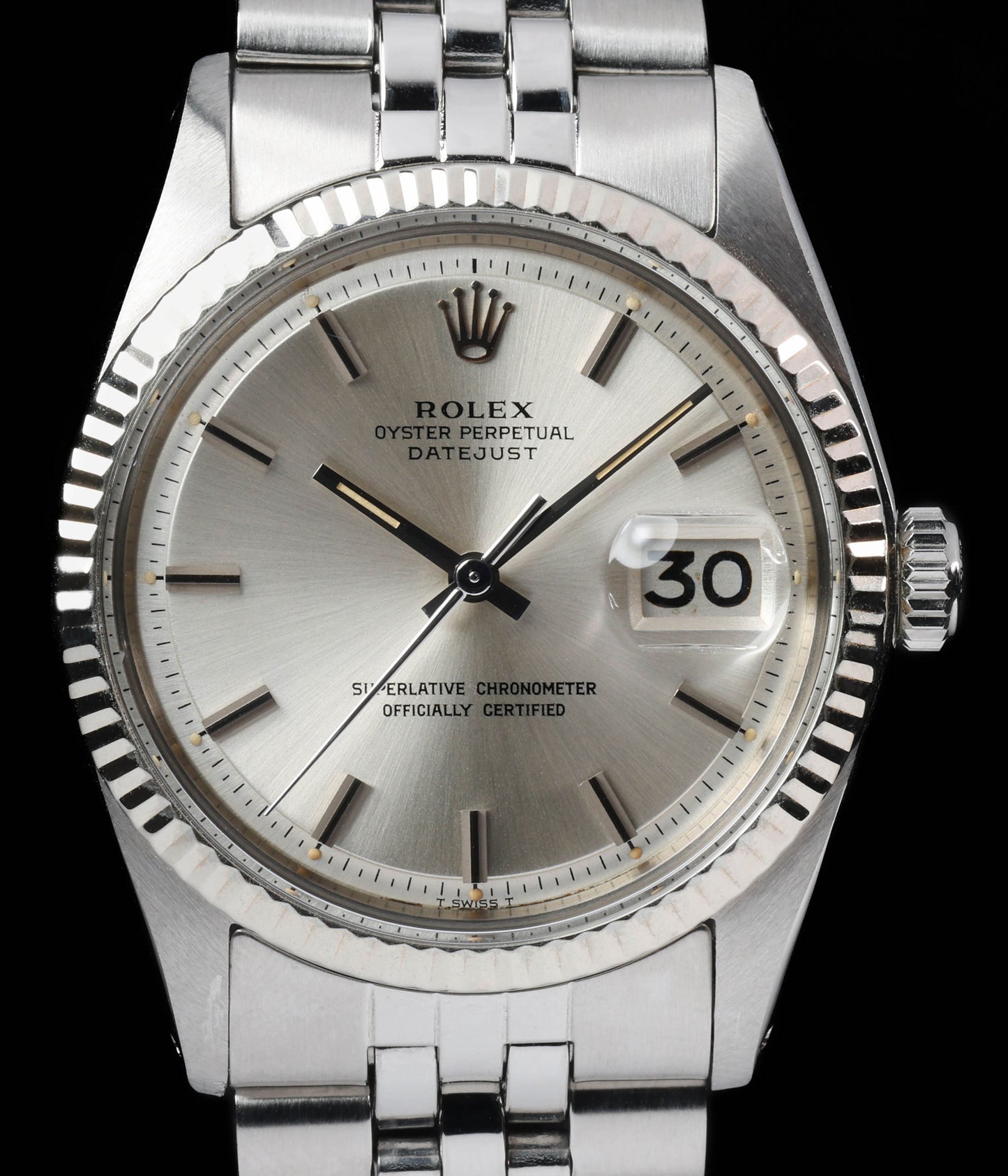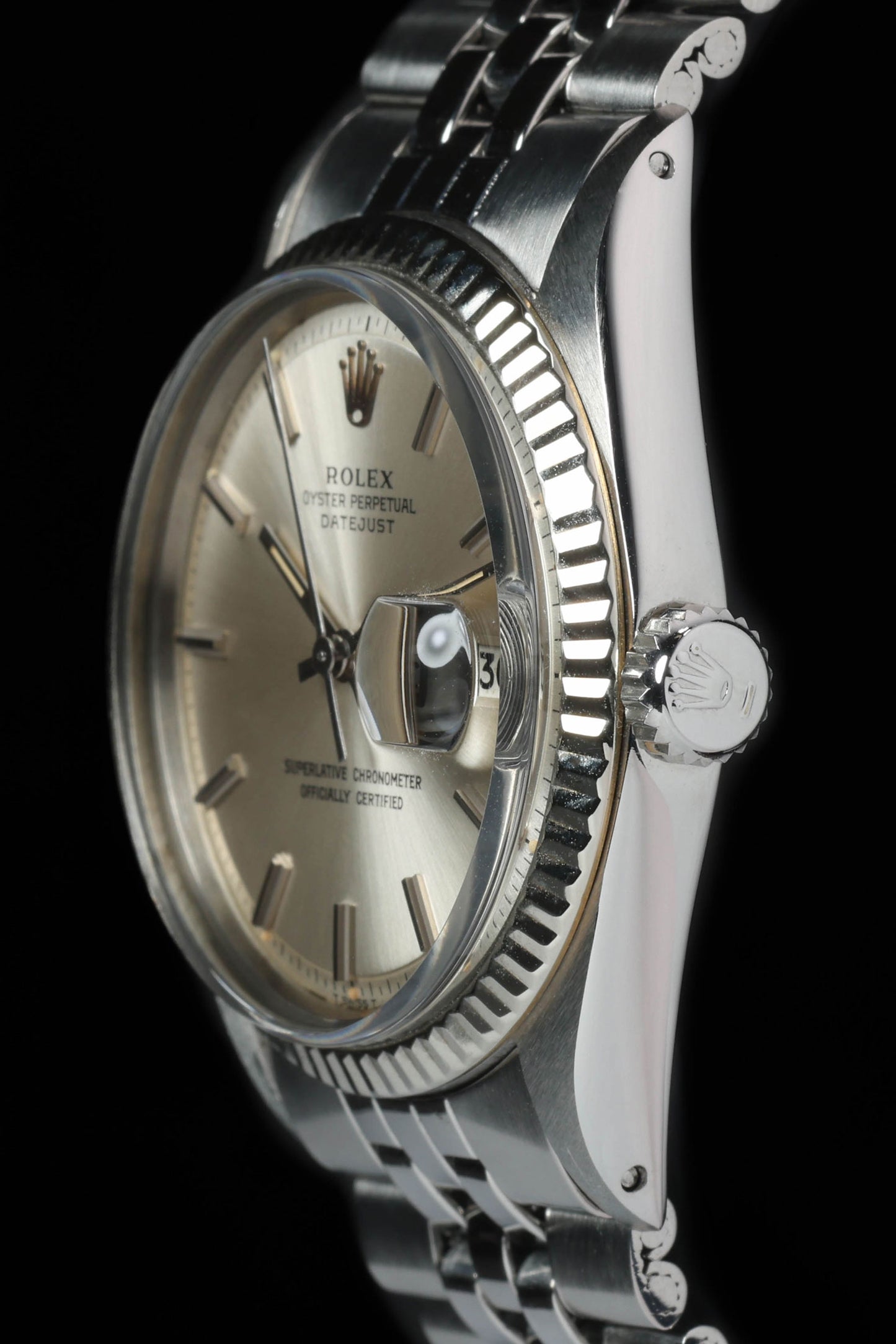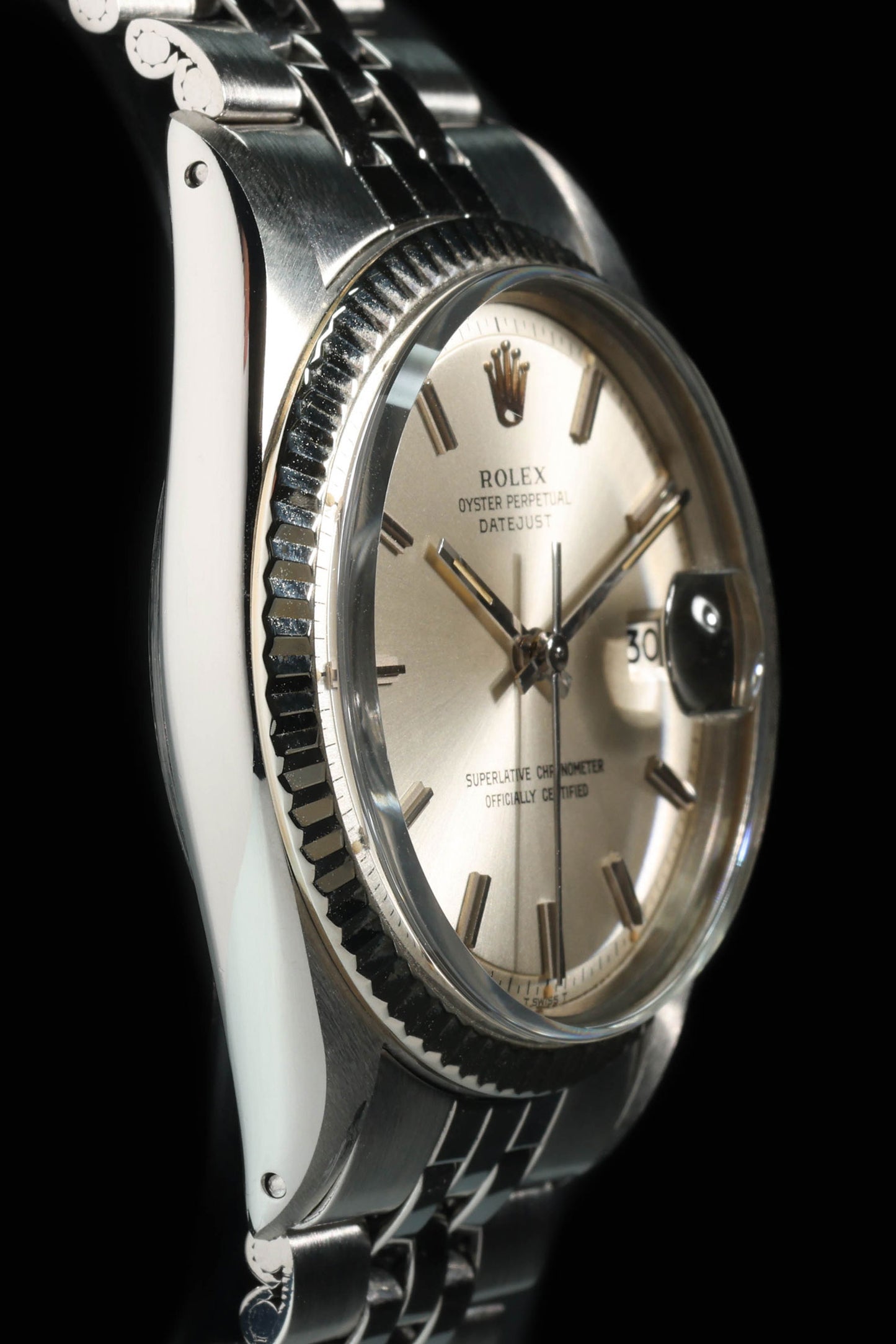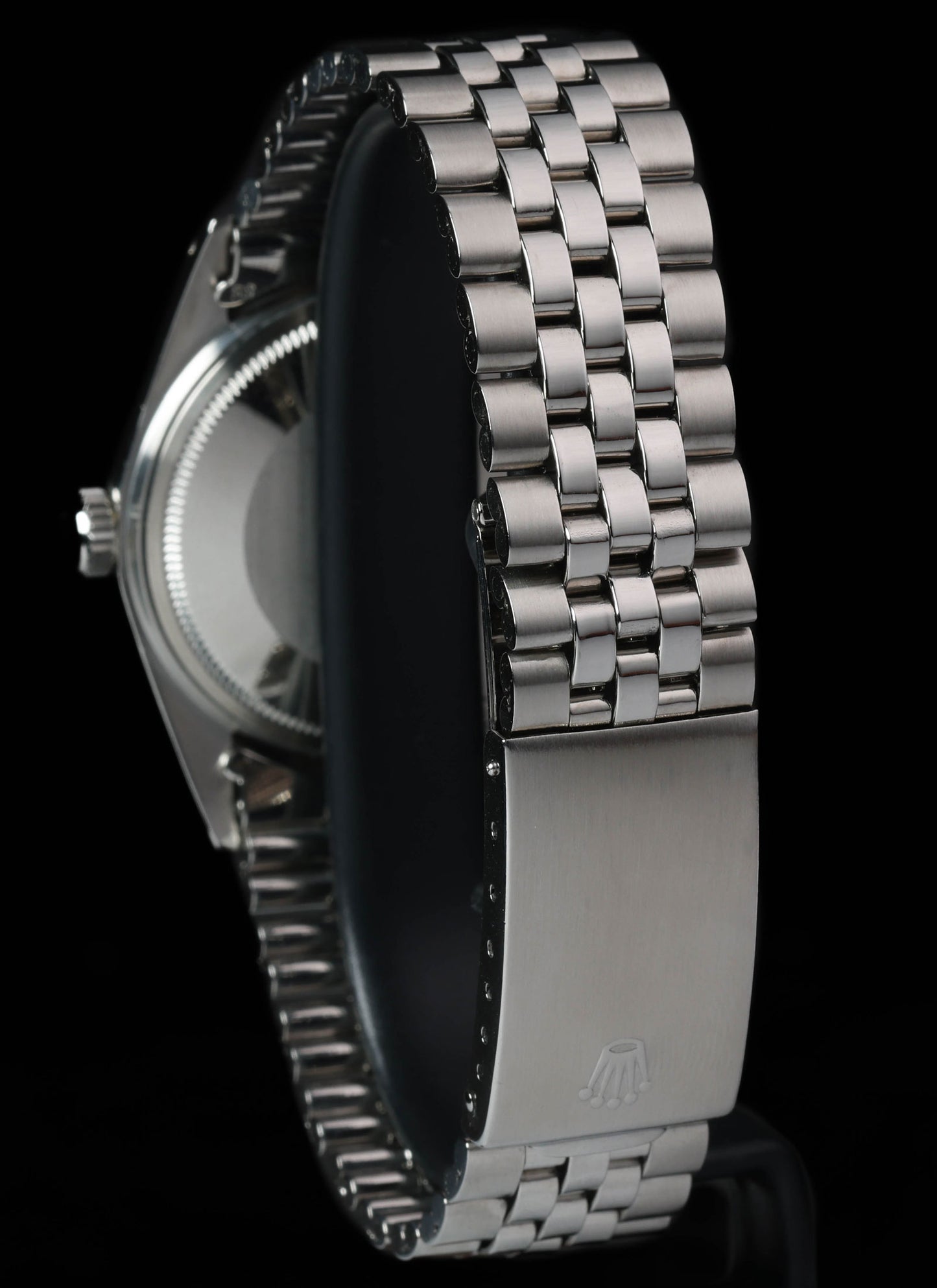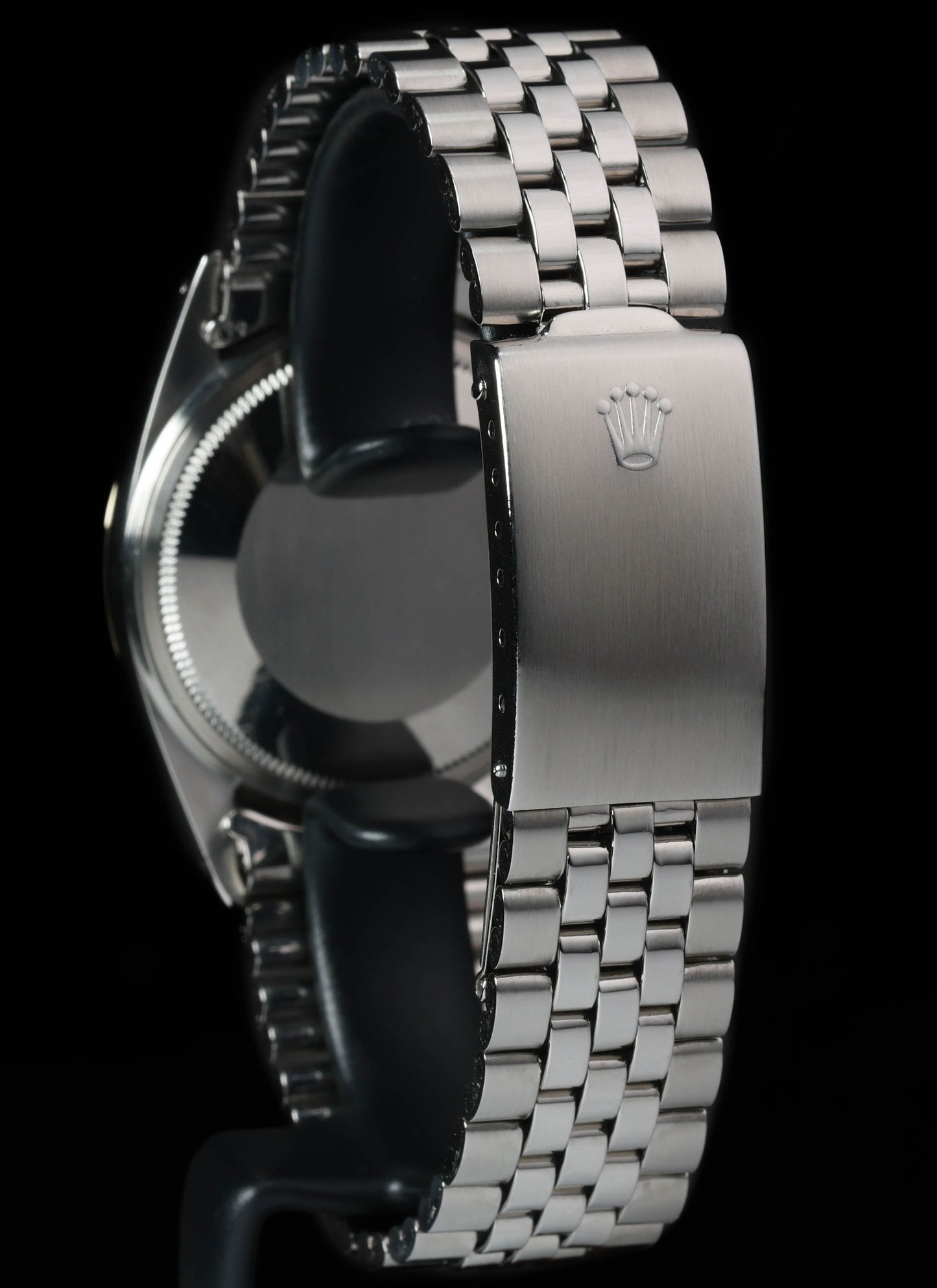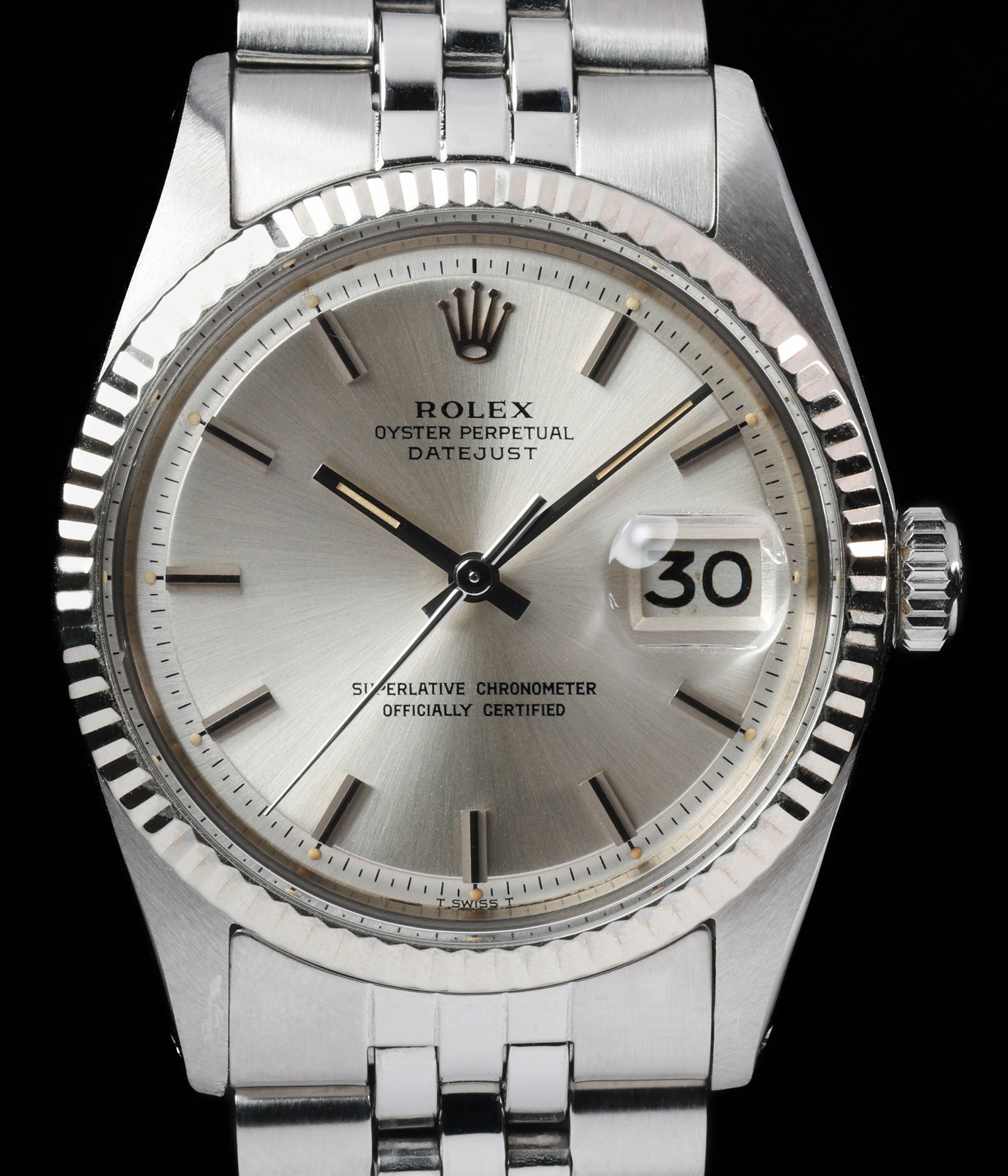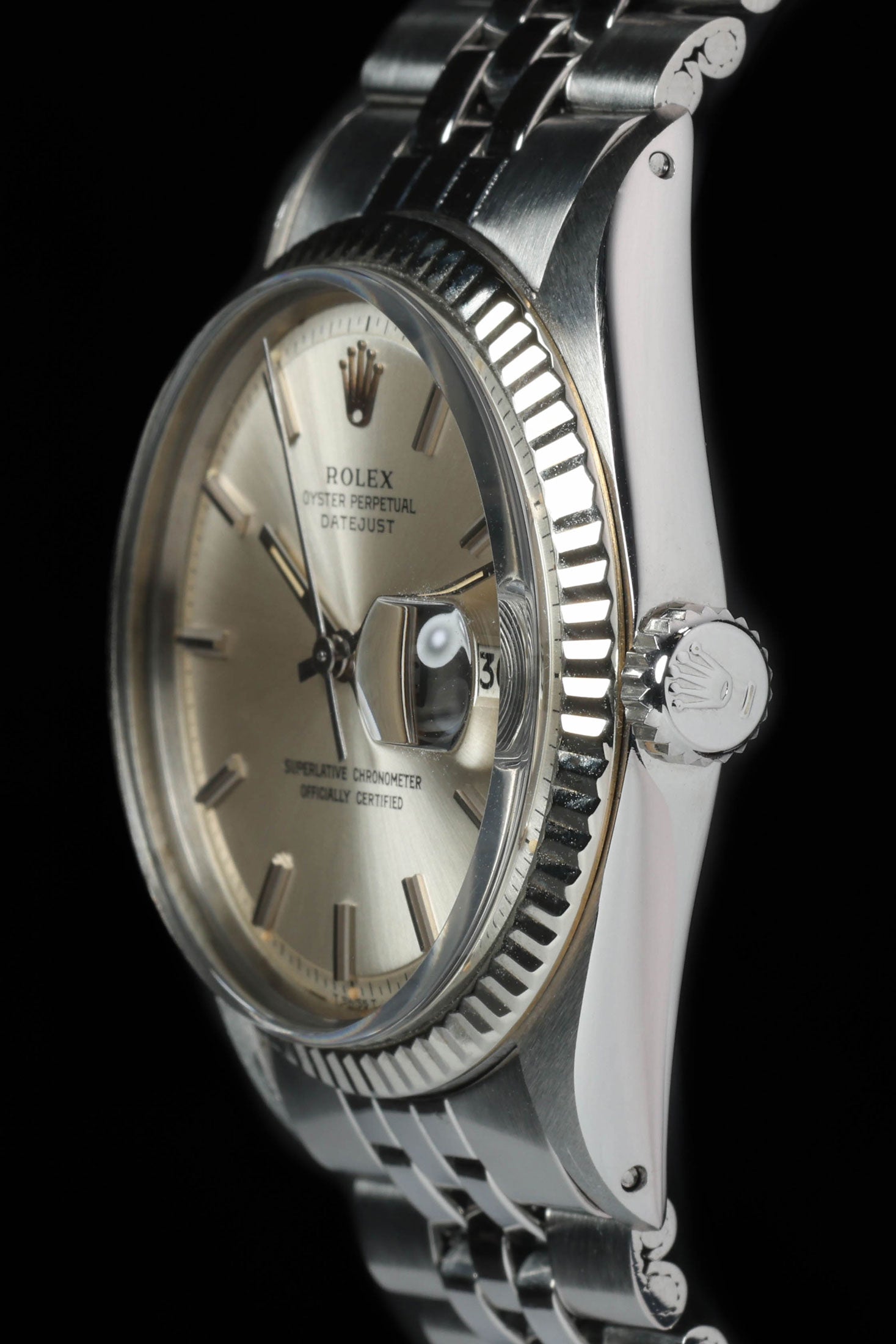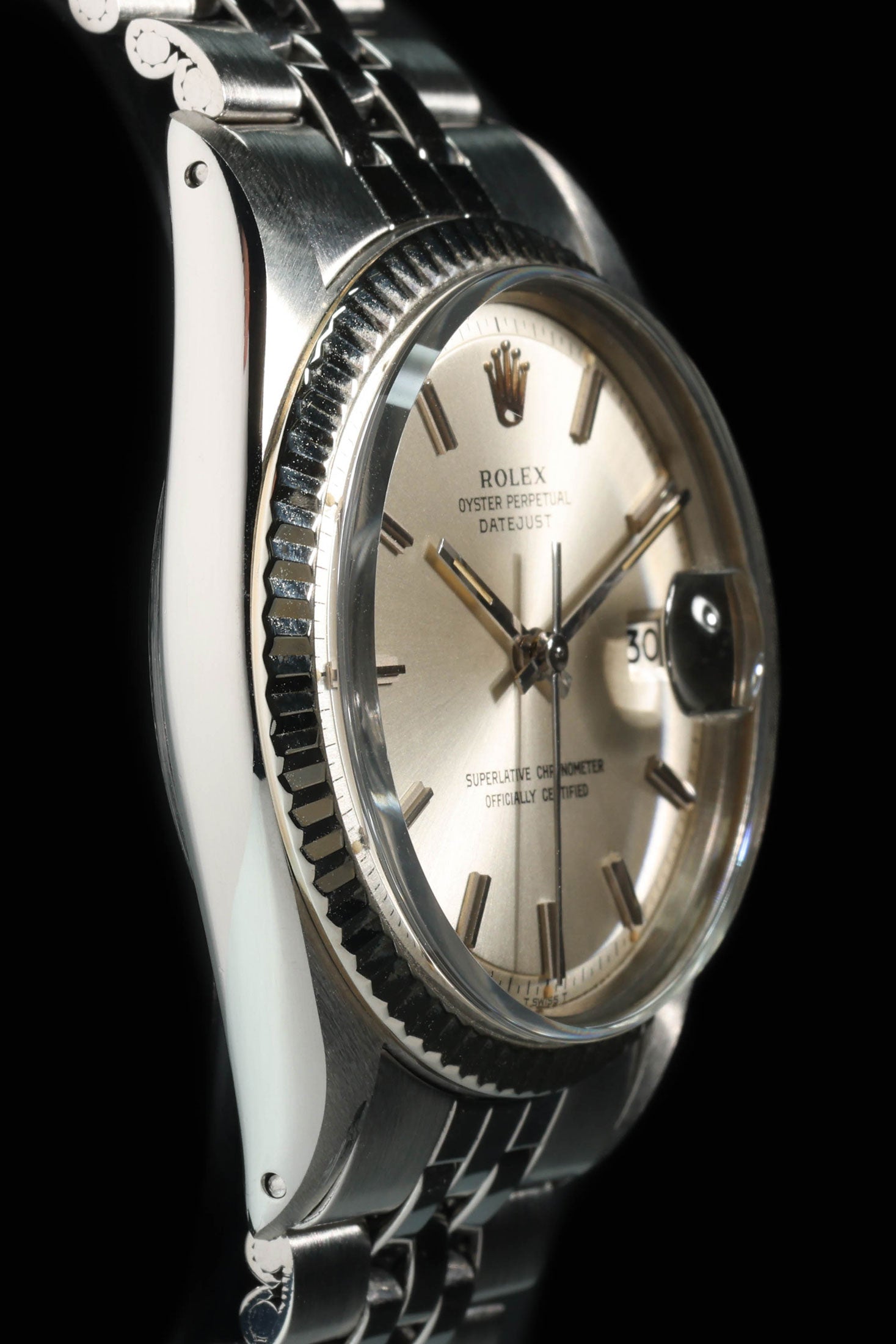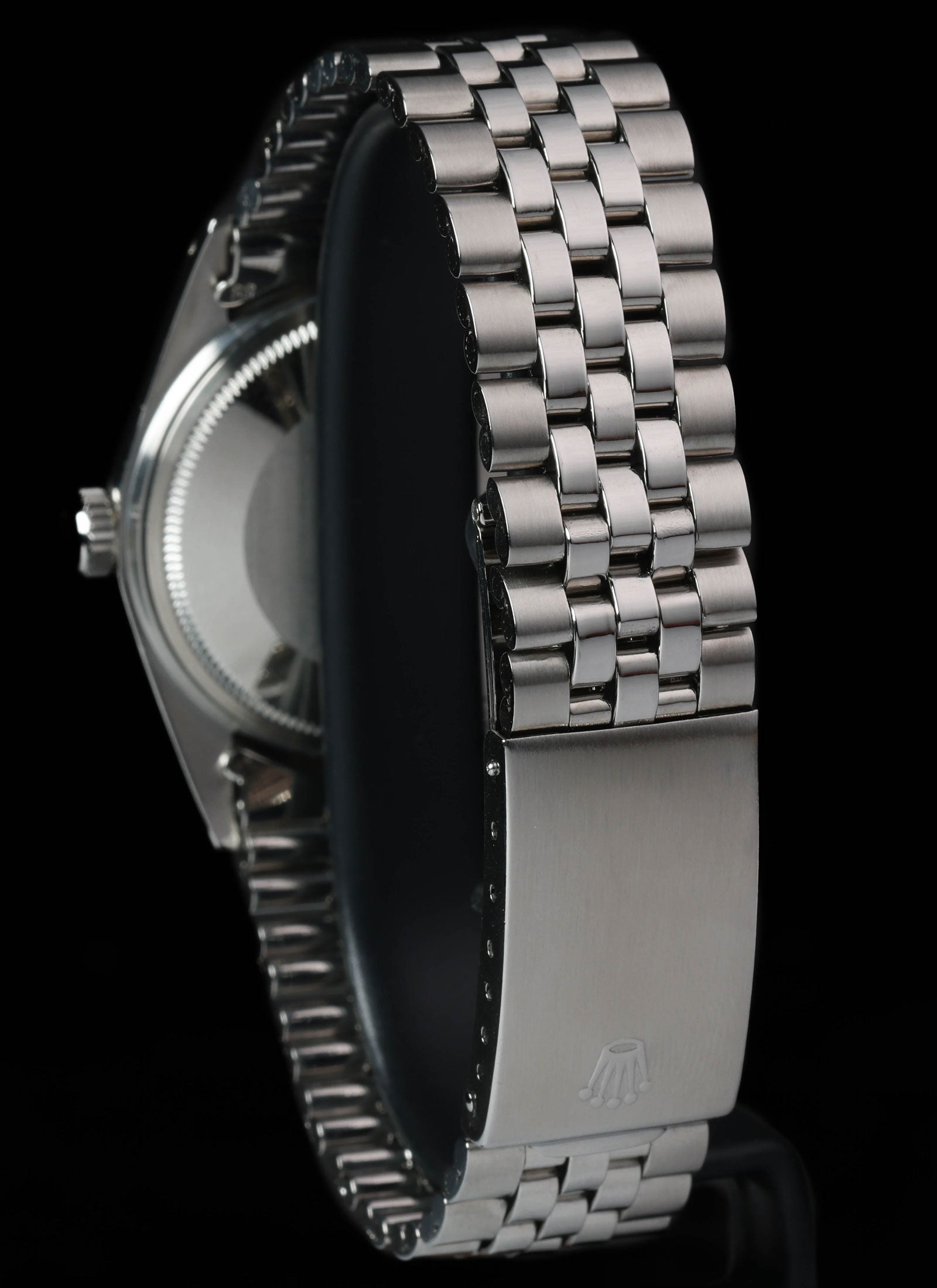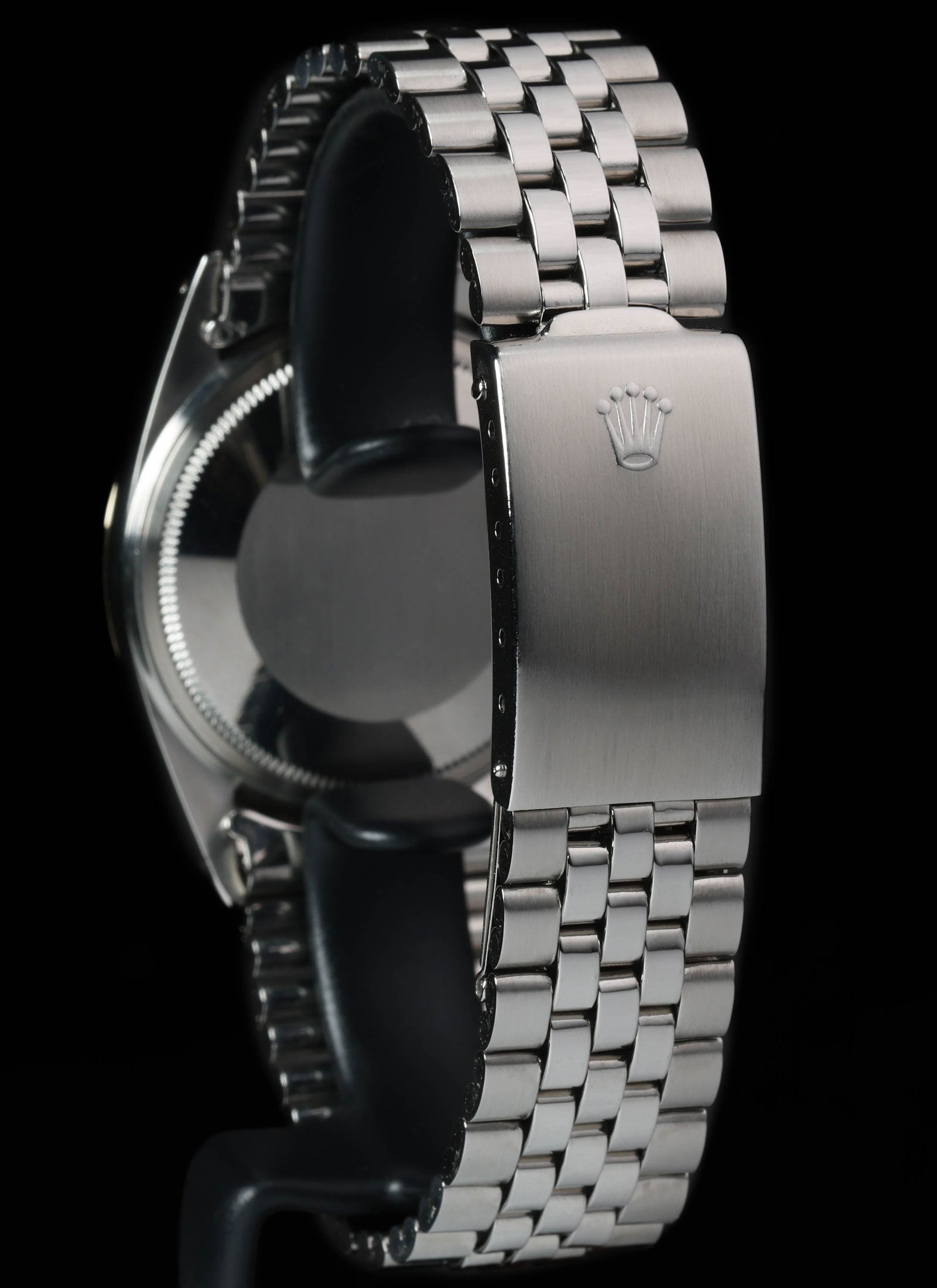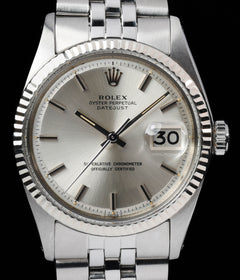Crown Vintage
Rolex Datejust 1601 'Pie-Pan' 36mm 1972
Rolex Datejust 1601 'Pie-Pan' 36mm 1972
Couldn't load pickup availability
Rolex Datejust 1601 'Pie-Pan'
The case remains in excellent condition, its fluted bezel crisp and the lugs retaining sharp geometry; only faint hairlines are visible on the lower-left lug. Bracelet presentation is equally strong—links are tight, surfaces clean, and stretch is minimal, reflecting careful wear. The silver sunburst dial is immaculate, tritium plots have mellowed to an even vanilla tone, and the hands are free of oxidation or lume loss, underscoring the remarkable preservation evident in our detailed photos. Overall, this 1601 stands well above typical examples from the era and one of the best we’ve seen. It would suit collectors seeking an uncommonly fresh Datejust, or someone after their first vintage watch. Now more than 50 years old, it should be treated as a vintage timepiece—do not swim with it and never wear it in the shower.
Share
Why we love this watch
Why we love this watch
Rolex Datejust 1601: The Archetypal Everyday Rolex
Origins of the Datejust Concept
When Rolex introduced the Datejust in 1945, the firm married two of its core innovations—automatic winding and the waterproof Oyster case—to a date complication that snapped exactly at midnight. The new model arrived on the brand-new Jubilee bracelet and took its name from that instantly “just” display of the date. Over the following decades the Datejust would become the most versatile model in the catalogue, able to straddle formal and casual settings while maintaining the rugged reliability that professional users had come to expect from the Crown.
Refining the Oyster Case and Fluted Bezel
By the early 1960s, Rolex had settled on a 36 mm Oyster case for the Datejust. Crafted from 904L stainless steel—known for its enhanced corrosion resistance—the mid-case featured graceful lugs that curved downward to hug the wrist. A screw-down “Twinlock” crown ensured the signature waterproofing, while the sharply fluted white-gold bezel added sparkle without resorting to gemstones. That bezel was more than decoration; its serrated profile originally helped watchmakers grip the ring when removing it to access the movement-securing case ring beneath.
Calibre 1570: Workhorse of a Generation
Powering reference 1601 is Rolex’s calibre 1570, a 26-jewel automatic movement running at 19,800 vph. It features a free-sprung balance with Microstella screws for precise regulation and an efficient bi-directional winding rotor riding on durable ruby rollers. A hacking seconds feature allows the wearer to set the time to the exact second—handy for professionals who require accuracy. The calibre’s architecture is renowned among watchmakers for straightforward servicing, yet its robustness means it can run for years between overhauls if kept sealed and worn regularly.
Dial Design and Lume Details
The silver sunburst dial shown here exemplifies the minimalist elegance of the Datejust line. Sunray brushing radiates from the cannon-pinion, catching light in a way that shifts from bright champagne to muted grey depending on angle. Polished baton hour markers feature thin black inlays known as “door-stop” bevels, boosting contrast against the dial surface. Each marker is paired with a discrete lume plot filled with tritium compound, giving a warm vanilla tone today. The alpha-shaped minute and hour hands share matching tritium infill, while the centre seconds hand carries a thin tapered profile to avoid obscuring the date window.
Cyclops Crystal and Date Window
Acrylic crystals were standard when the reference 1601 left Geneva. Rolex moulded a 2.5× magnifier—nicknamed the “Cyclops”—directly above the date aperture at 3 o’clock. This simple lens remains one of the most recognisable Rolex signatures, enlarging the numeral for at-a-glance reading. The aperture itself is framed by a crisp milled edge in the dial plate, and the date disc uses a distinctive “open-six, open-nine” serif typeface that collectors now associate with mid-century Rolex typography.
Case and Bracelet Construction
The watch arrives on a five-link Jubilee bracelet that flows seamlessly from the mid-case thanks to solid, 20 mm end-links stamped 55. Outer links are satin-brushed for a tool-like appearance, while polished centre links catch ambient light, giving the bracelet its characteristic shimmer. Hollow links, though lighter than modern solid equivalents, grant exceptional drape and comfort in warm Australian summers. A sturdy, stamped-steel foldover clasp features the Rolex coronet and allows micro-adjustment via a spring-bar system concealed beneath the cover.
Everyday Practicality
With a case thickness under 12 mm, the 1601 slides neatly under a shirt cuff and feels well balanced on a broad range of wrist sizes. The screw-down crown offers reliable moisture protection for daily wear—from a morning surf check to a late-night tram ride across town. The 100-metre water-resistance rating, generous for the era, came courtesy of the patented Oyster construction that paired a threaded case-back with precisely machined tube-and-gasket sealing.
Cultural Footprint
The Datejust became shorthand for achievement throughout the post-war decades. Heads of state, business leaders and Hollywood icons all adopted the fluted-bezel classic as an understated badge of success. Its appearance on the wrists of figures ranging from Paul Newman to the Dalai Lama cemented the model’s reputation as the ultimate go-anywhere, do-anything luxury watch. Few timepieces can claim equal footing at a board meeting, a backyard barbecue and a black-tie fundraiser.
Design Evolution and Reference Codes
Rolex employed a logical reference-code system: the 160x family denoted a Datejust with fluted bezel, while the final digit indicated the material. The “1” of 1601 specifies a stainless-steel case topped by a white-gold bezel, whereas 1603 identifies a rolled-steel engine-turned bezel and 1600 signals a smooth steel bezel. That clarity allowed clients to choose aesthetic and budget preferences without guesswork—an early example of modular product planning long before the term entered MBA textbooks.
Dial Variations and Regional Nuances
Although silver sunburst remains the most iconic, Rolex produced the 1601 with a broad spectrum of dial colours and textures: matte black, champagne, linen, mosaic and even exotic “wide-boy” marker layouts. Some regions received specialised configurations; for instance, European markets often saw dials signed “σ T Swiss T σ,” the twin sigma symbols indicating solid-gold markers and hands. Similarly, calendar wheels could display bilingual date discs—English-Spanish for Latin America, English-Kanji for Japan—reflecting Rolex’s global aspirations.
Accuracy Standards and COSC Certification
Every Datejust movement left the factory as a certified chronometer, having passed COSC tests for average daily rate, mean rate variation and positional variance. The calibre 1570 routinely returned results better than the −4/+6 seconds-per-day threshold, earning Rolex the right to print “Superlative Chronometer Officially Certified” on the dial. This commitment to precision resonated with professionals—engineers, pilots, naval officers—who valued reliability over ornamentation.
Relatability Across Generations
One of the Datejust’s enduring strengths is how effortlessly it keeps pace with shifting fashion. The 36 mm case sat at the sporty end of men’s sizing in the 1970s, yet feels refreshingly restrained in today’s era of oversized designs. Its proportions also suit many women who prefer a watch with presence but not excessive bulk. That cross-generational appeal has ensured the model remains a staple in Rolex boutiques and vintage dealers alike.
Materials and Finishing Techniques
Rolex employed superior metallurgy, switching to high-nickel 904L steel well before most competitors. The metal’s resistance to pitting and staining makes it ideal for humid coastal climates such as Sydney or Cairns. White gold used for the bezel and hands gains a subtle patina over decades, softening reflections without losing the underlying lustre. Dial text is pad-printed in glossy black lacquer, and hour markers receive hand-applied facets that catch the afternoon sun with a discrete glint.
Movement Servicing Philosophy
Calibre 1570’s modular design means components such as the automatic bridge, mainspring barrel and keyless works can be accessed independently—reducing bench time during routine overhauls. The free-sprung balance uses four Microstella screws, allowing a watchmaker to fine-tune rate without the long-term drift associated with index-regulated systems. A robust escapement and deep-draw mainspring teeth contribute to the movement’s reputation for shrugging off everyday shocks.
Legacy Within the Datejust Line
The reference 1601 represents the final evolution before Rolex moved to quickset date functionality in the late 1970s. While later models gained convenience, some enthusiasts still favour the earlier non-quickset versions for their thinner cases and romantic “slow set” midnight date change—a tiny ritual that harks back to a mechanical age. The 1601 also bridges the aesthetic gap between early pie-pan dials of the 1950s and the flat dials introduced in subsequent references, making it a versatile link in the Datejust timeline.
Condition and Presentation
This particular example shows crisp lug chamfers and deep, even fluting on the bezel—signs that any past polishing was both minimal and respectful. The sunburst dial retains its original grain, free of spotting or moisture damage, while tritium lume plots have aged to a uniform almond hue that glows faintly after a burst of light. The Jubilee bracelet exhibits negligible stretch, indicating limited wear and careful storage. Together these traits present a watch that looks ready for decades of service, whether paired with a tailored suit or linen shirt.
Everyday Wearing Experience
On the wrist the 1601 feels balanced, neither top-heavy nor overly light. The Jubilee bracelet articulates around the contours of the forearm, preventing hot-spots during Australia’s warmer months. Legibility is excellent: black hash marks on the minute track contrast against the silver dial, and the bold baton hands trace time with clarity. The tactile click of the screw-down crown and the audible “pop” of the crystal magnifier under running water reinforce the sense of a precision instrument.
Influence on Modern Watch Design
Today’s Datejust 36 still echoes the blueprint laid down by the 1601: same 36 mm case diameter, fluted bezel option, Cyclops, Jubilee bracelet and chronometer-certified movement. Even rivals in the luxury segment—such as the Omega Constellation and Grand Seiko 44GS—have adopted similar combinations of robust sports capability with dress-ready finishing, a testament to the template Rolex established.
Sustainable Appeal
Mechanical watches offer intrinsic longevity, with renewable energy supplied by the wearer’s wrist and serviceable movements designed for centuries of use. The 1601 exemplifies this sustainable ethos: no battery, no planned obsolescence, just a classic design that can be maintained indefinitely with proper care. In an era focused on responsible consumption, such durable goods carry renewed relevance.
Final Thoughts
The Rolex Datejust 1601 distils the brand’s core virtues into a form that feels as current today as it did on release. Its fluted white-gold bezel and sunburst dial lend subtle refinement, while the Oyster case and calibre 1570 deliver everyday reliability. Worn with board shorts on Bondi or a blazer in the boardroom, this reference proves that true versatility never dates.
Case & Bracelet
Case & Bracelet
- Case in excellent condition with minor hairlines on bottom left lug. Bracelet remains in excellent condition with no wear and minimal stretch.
Dial & Hands
Dial & Hands
Dial and hands in excellent condition.
Warranty & Condition
Warranty & Condition
Crown Vintage Watches provides a minimum 3-month mechanical warranty on pre-owned watches, from the date of purchase.
The warranty covers mechanical defects only.
The warranty does not cover damages such as scratches, finish, crystals, glass, straps (leather, fabric or rubber damage due to wear and tear), damage resulting from wear under conditions exceeding the watch manufacturer’s water resistance limitations, and damage due to physical and or accidental abuse.
Please note, water resistance is neither tested nor guaranteed.
Shipping and insurance costs for warranty returns to us must be covered by the customer. Returns must be shipped via traceable courier. Return shipment must be pre-paid and fully insured. Collect shipping will be refused. In case of loss or damages, the customer is liable.
Our Pledge
At Crown Vintage Watches, we stand by the authenticity of every product we sell. For added peace of mind, customers are welcome to have items independently authenticated at their own expense.
Condition
Due to the nature of vintage timepieces, all watches are sold as is. We will accurately describe the current condition and working order of all watches we sell to the best of our ability.
Shipping & Refund
Shipping & Refund
